Too soft to move the strong lilies.
Touches the wisteria’s new lavender blooms,
Clustered like graceful fingers
Pointing down at the sacred ground.
A dove in silence feeds on scattered seeds
As the air’s light currents
Suddenly gust through the deep green rose leaves
And up to the eucalyptus’ tangled top.
My spirit stops there;
Then, as the dove lifts up
On the wind-breath,
My heart flies with her wings.
April is a glorious month, filled with every kind of bird and flower, with clean green breezes and gentle rain. We welcome with joy the powerful creativity of this energetic month. April is spring at her very best. It is not surprising that some of the world’s most significant spiritual celebrations of rebirth and renewal take place at this regenerative time. This year, Easter and Passover both fall in April. And in Japan, the Birth of the Buddha is always celebrated in April.
This year, Passover begins at sundown on Wednesday, April 8 (also the birthday of the Buddha,) and Easter is Sunday, April 12. These important religious observances take place in early spring, although the dates for Passover and Easter change from year to year based on somewhat complex calculations. The Hebrew calendar is lunisolar, meaning that the months are based on the moon and the years are based on the sun. The Jewish year begins in September and includes twelve lunar months, each beginning with a new moon. Passover takes place during the 14th day of the month of Nisan, the seventh month, during the full moon. In Western Christianity, based on the Gregorian calendar, Easter takes place on the first Sunday following the full moon on or after the Vernal Equinox. If you find this explanation confusing, you are not alone.
Perhaps it is best just to keep in mind that these two holidays are related in the sense that Jesus, whose resurrection is celebrated on Easter, died and was reborn during Passover. In fact, the Last Supper, immortalized by Leonardo da Vinci’s famous painting, took place when Jesus and his disciples, all of whom were Jewish, were eating the Seder, or Passover meal commemorating the liberation of the People of Israel, who were led out of slavery in Egypt by Moses. Easter and Passover are the most important religious holidays in Christianity and Judaism respectively.
Both holidays are also filled with symbolism. The Seder meal, which is a religious service set around the family dinner table, includes foods that symbolize the tribulations of the people of Israel prior to their liberation from slavery. Bitter herbs suggest the bitterness of slavery, salt reminds the faithful of the tears of the slaves and matzoh, a flatbread, commemorates the unleavened bread carried with the people when in their rush to freedom, they had no time for the leavened bread to rise. A lamb shank is also part of the ceremony, reminiscent of the events described in the eleventh and twelfth chapters of the Book of Exodus when God struck down the first born of all the Egyptians but instructed Moses to tell each Jewish family to sacrifice a lamb and place the blood on the upper door posts of their homes so that God would “pass over” them when punishing the Egyptians for refusing to set the people of Israel free. The Passover service itself is also described in this Biblical passage, telling the people to celebrate this Feast of Unleavened Bread in perpetuity.
Another symbolic item on the Seder dinner plate is a boiled egg, an obvious connection with the Easter celebration. Easter eggs, along with yeast breads, lambs and freshly blooming flowers, symbolize rebirth, hope and creative energy. The boiled egg at the Passover meal seems to have a dual meaning, its archetypal significance as a symbol of new life and a more specific commemoration of mourning for the destruction of the Temple in Jerusalem by the Romans in the year 70 CE. It was the custom at that time to present a boiled egg along with the sacrificial lamb at the Temple as an offering to God. Since the events remembered at the Seder meal as described in the Book of Exodus took place about 3,000 years ago after the People of Israel had already been enslaved for 400 years, the introduction of the egg to the Seder meal came at a much later time. Indeed, symbols are living and evolving, along with the customs and ceremonies of human life.
While I am fascinated by the history of symbolism, nature herself is loaded with literal images of new life and resurrection, especially in April. For every bird who sings in the spring, there was an egg from which he emerged. Even from the factual perspective, eggs are the perfect symbol for rebirth.
As my Easter gift to you this year, I offer a profoundly symbolic recipe from our website: Danish Pastry Easter Wreath. With an Easter Egg in its center and colorful little chocolate eggs surrounding it, this round pastry symbolizes the eternal circle of life, new birth, and resurrection through the use of yeast dough, which miraculously rises from a flat pile of flour.
This recipe appears on our website in our Christmas Tea menu as an edible Christmas wreath, celebrating the birth of a child, and in nature the rebirth of light over darkness and warmth over cold as the depth of winter promises to give way to the radiance of spring.
Do not be intimidated by the length and apparent complexity of this recipe. Unlike my co-author and niece Kathleen, I am not an expert at yeast baking, but I have made this Danish Pastry Wreath numerous times over the years for Christmas and Easter without a single failure. I found the recipe in the excellent and reliable McCall’s Bake-It Book, copyrighted from 1971-1975.
I adapted the very clear instructions in the McCall’s recipe into a fourteen-step format that is very easy to follow. Your only challenge is to set aside an entire day (or two half days) for this project. I find that my time in the kitchen is happiest , especially when making a time-consuming recipe, when I am completely alone and have no further appointments scheduled for the day. As you create the dough, braid the wreath, set it aside for rising, bake and decorate this beautiful celebratory pastry, keep in mind that your hours of work are a gift of gratitude for those you love.
Danish Pastry Easter Wreath
You will be delighted to discover that the recipe for this Danish Pastry Easter Wreath will produce two large buttery almond flavored pastry wreaths, one for the feast on Easter Day, and one to serve at a special breakfast or springtime brunch. The baked wreaths can be carefully wrapped and frozen. After thawing, these wreaths can be gently warmed, iced and decorated for Easter presentation with a colored Easter egg in the center of each wreath and a circle of small pastel chocolate eggs surrounding each. If you and your family do not celebrate Easter, select any spring decorations that suit you, and charm your friends with this magnificent tribute to the season.
Check the list of ingredients and the special equipment list before you start making your Easter Wreaths. This recipe requires a pound of butter, two packages of active dry yeast, a package of almond paste, toasted slivered almonds and graham cracker crumbs, among other ingredients, that you may or may not normally keep in your kitchen cupboard, and you will need a cooking thermometer. Also, the entire process takes five to six hours, including periods of time for the dough to chill and rise during the various steps in creating your masterpiece.
For the dough:
- 1 ½ cups (3 sticks) butter, softened
- ¼ cup flour
- ¾ cup whole milk
- 1/3 cup sugar
- 1 teaspoon salt
- ½ cup warm water (105-115 degrees F)
- 2 packages active dry yeast
- 1 large egg
- 3 ¾ cups flour
For the filling:
- 1 (8-ounce) can or package almond paste
- ¾ cup graham cracker crumbs
- ½ cup (1 stick) butter, melted
- 1 egg
- ½ teaspoon almond extract
For the icing and decorations:
- 2 cups powdered sugar
- 3-4 tablespoons milk
- ½ cup sliced toasted almonds (optional)
- 2 colored Easter eggs (to place in the center of each pastry)
- Small pastel chocolate Easter egg candies
- Colored sprinkles or sugar crystals (optional)
Preheat oven to 375 degrees F (after dough is prepared)
Special equipment:
Large mixing bowl, waxed paper, ruler, wooden spoon, cooking thermometer, glass measuring cup, pastry cloth, medium sized mixing bowl, rolling pin, aluminum foil, large sharp knife, fork, 2 large baking sheets, parchment paper, plastic wrap, large serving platter (about 12”) or cake pedestal
Makes: 2 braided pastry wreaths, about 11” each, 8-12 servings each
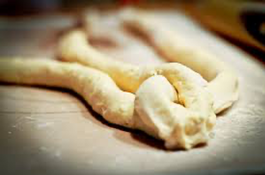
- Bring butter and egg to room temperature. In a large bowl with a wooden spoon, beat the butter and ¼ cup flour until smooth. Spread on waxed paper on a wet surface to a 12” x 8” rectangle. Refrigerate on a cookie sheet.
- Heat ¾ cup milk slightly in the microwave in a glass measuring cup. Add sugar and salt and stir to dissolve. Cool to lukewarm.
- Check the temperature of the very warm water with a thermometer. It should be between 105 and 115° F. Pour the warm water into a large bowl, sprinkle the yeast over the water and stir to dissolve. Stir in the milk mixture, egg and 3 cups of flour. Beat with a wooden spoon until smooth. Mix in the rest of the flour by hand until the dough leaves the side of the bowl.
- Refrigerate, covered, for ½ hour. Turn the dough out onto a lightly floured pastry cloth and roll into a 16 x 12” rectangle.
- Place the chilled butter mixture on half of the dough and remove the waxed paper. Fold the other half of the dough over the butter and pinch the edges to seal.
- With the fold at the right, roll the dough out from the center to a 16” x 8” rectangle. From the short side, fold the dough into thirds, making 3 layers. Seal the edges and chill for 1 hour.
- Repeat rolling and folding into thirds several times. (If butter breaks through, brush with flour.) Seal the edges and chill for ½ hour.
- Roll, fold again, and seal the edges. Chill the dough, wrapped in foil, for 3 hours or overnight. Cut the dough into 2 equal pieces. Wrap and chill one half. Roll the other half into a 22 x 8” strip. This will take some effort, as the dough is very cold and may need to be stretched by hand. Cut the rectangle of dough into thirds lengthwise.
- Melt the butter for the filling and mix all of the filling ingredients in a medium sized bowl with a wooden spoon. Use a fork also to make sure the almond paste is well incorporated into the filling. Fill the center of each strip of dough with 1/3 cup of filling, distributed evenly along the length of the strip. Closes the edges over the filling, pinching the edges together tightly so that no filling is visible.
- Place the 3 ropes of filled dough side by side, pinch the tops together, and loosely braid the ropes together, keeping the seams facing downward.
- Form the dough braid into a circular shaped wreath and place it on a parchment-lined cookie sheet. Seal the top and bottom sections to adhere and adjust the shape into a circle about 6” across in the center. Repeat the rolling, filling and braiding process with the second half of the dough, form the braid into a wreath, and place it on a second parchment-lined baking sheet.
- Place the wreaths in a warm place to rise until doubled, about 1 hour.
- Preheat the oven to 375° F. Bake the wreaths on the 2 cookie sheets for 25-30 minutes. If making ahead, cool on racks, and when completely cool, wrap carefully in plastic and aluminum foil and freeze. To serve, thaw completely while still wrapped, remove the plastic wrap and wrap loosely in foil. Place on cookie sheets and warm in a 350° F oven for 10 minutes. Remove the foil, place on a decorative platter or pedestal and follow the instructions in step 14.
- If serving immediately, mix the powdered sugar and milk and drizzle the glaze over the warm pastries. Scatter toasted sliced almonds over each wreath and place a colored Easter egg in the center. Decorate with colored sprinkles or sugar crystals if you wish, or place miniature pastel chocolate Easter Eggs around each wreath. Serve warm.

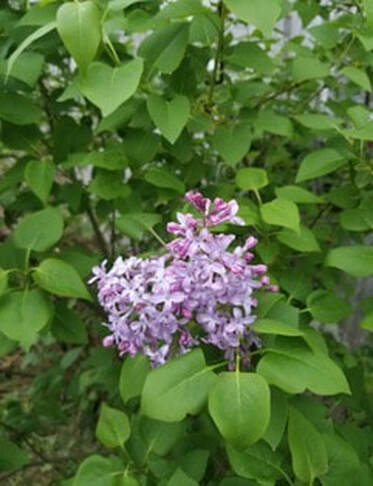


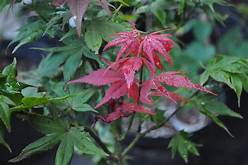
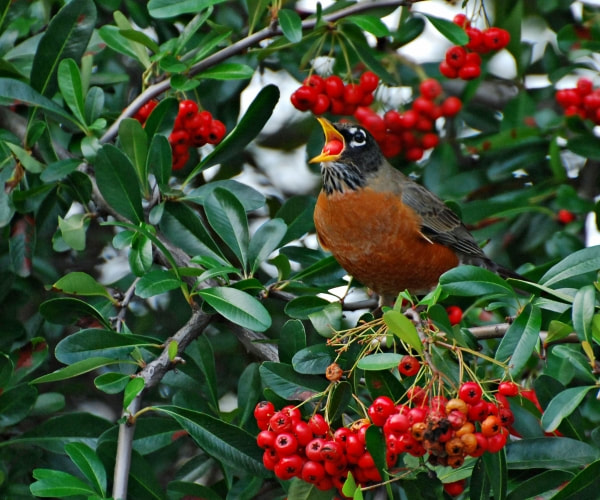
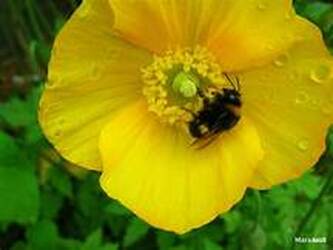
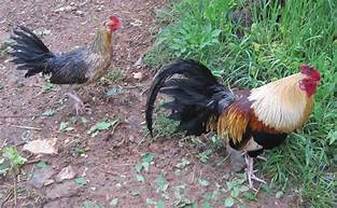

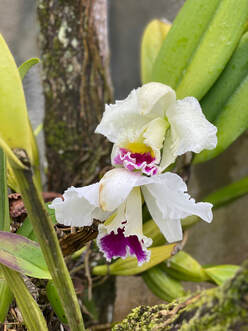
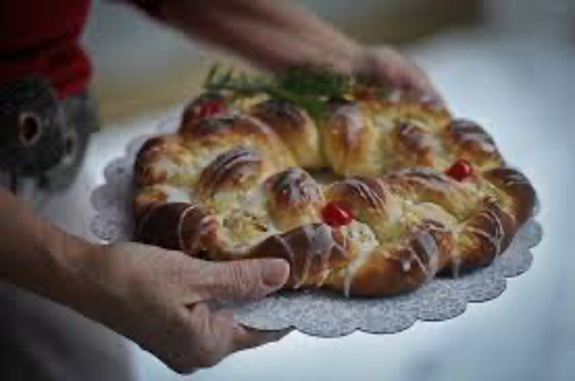
 RSS Feed
RSS Feed